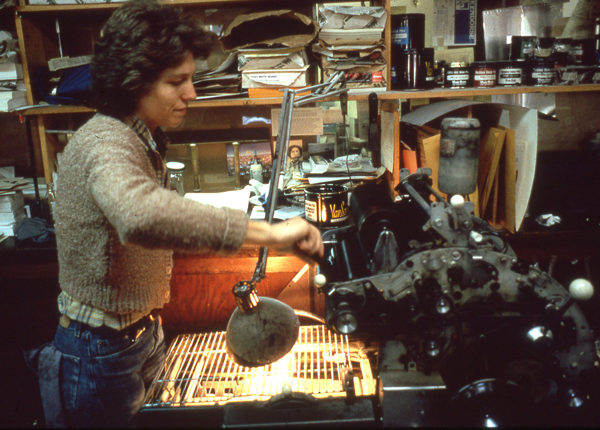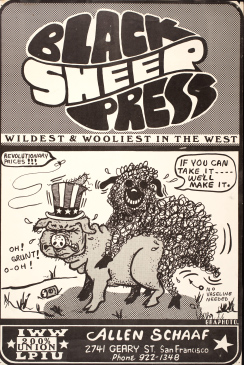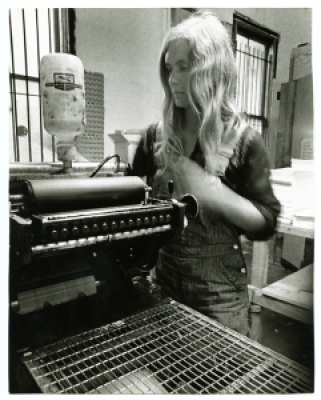Directory of San Francisco Bay Area political poster
workshops, print shops, and distributors
This was originally published in All
Of Us Or None: Social Justice Posters of the San Francisco Bay Area,
by Lincoln Cushing, Heyday, 2012; extensive and expanding online
collection viewable at
Oakland Museum of California
For cataloging geeks, the Library of Congress Subject Heading for this
field is "Printers--Political
activity--History--United States"
The information officers of the New American Left have rediscovered an ancient political ally: print power.
All over the country, radical and "movement" organizations have spawned their own print shops run by their own pressmen to churn out an increasing number of posters, pamphlets, handbills, and flyers. Whether it's to mobilize a march on Washington, explain the advantages of "Free Speech” for GIs, or advertise courses at "Omega U. - an alternative university, the rebel presses are rolling. By the thousands, their folded-and-stapled brochures, decorated with crude graphics, are being given away at hastily set up campus tables or sold in the standard subculture outlets: Barbara's Bookshop in Chicago, the Granma in Berkeley, the Militant Labor Forum in New York, and scores of others.
-“Young Radicals Rediscover and Use the Power of the Press,” Associated Press, July 8, 1970. Photo: Beth Tapscott running A.B. Dick 360, Inkworks Press, Oakland, circa 1983. photo by Lincoln Cushing, former operator of that press.
Two key vectors were crucial to the modern political poster renaissance – the means for making the posters and the means for distributing them. Almost all of these posters were either printed by hand in small workshops (usually by screen printing) or were produced at sympathetic offset print shops. New technologies allowed for easier and cheaper ways to create type and to print smaller quantities than ever before. And as people started wanting posters to put on their walls, new distribution channels evolved. Head shops, bookstores, and poster stores provided the physical space to see and buy posters, and artist-run cooperatives made it easy to order them by mail.
Below
is a survey of the main points of production. Generally not included
here are small workshops out of art schools, individual artist’s
studios, organizational in-house shops not open to outside projects, or
“friendly” shops (those not formally dedicated to political work, but
consistently supportive), such as Autumn Press.
Direct links:
Alliance Graphics | The Berkeley Bonaparte | Berkeley Graphic Arts/Berkeley Free Press | Bindweed Press | Black Panther Party press | Black Sheep Press | Chicano Art Center | Chubasco Press | Community Asian Art & Media Project | Double-H Press | East Bay Media Center | Fireworks Graphics Collective | FITS Printing | Five Trees Press | Free Print Shop | Free Speech Movement Press | Gonna Rise Again Graphics | Graphic Arts of Marin | Graphic Arts Workshop | Greenleaf Press | Inkworks Press | Japantown Art and Media | Jellyroll Press | Jungle Press | Kearny Street Workshop | La Raza Graphics Collective | La Raza Silkscreen Center | The Media Project | Mission Grafica | New Americas Press | New Earth Press | Noe Valley Silkscreen Collective | Noh Directions Press | Orbit Graphic Arts | People's Press | Popular Press | The Print Mint | Rainbow Zenith | Royal Chicano Air Force | San Francisco Community Press | San Francisco Print Collective | San Francisco Printing Coop | Sequoyah Graphics | Solidarity Publications | Taller de Artes Graficas | Taller Sin Fronteras | Taller Tupac Amaru | Tea Lautrec Litho | Up Press | Women's Press Project
Reproduction facilities
Alliance Graphics
Berkeley, 1990-present; screenprint
Alliance Graphics derived its name as the “profit making” division of the activist nonprofit Middle East Children’s Alliance. Although mostly known as the movement facility for custom T-shirts and other merchandise, Alliance has also produced thousands of posters for a wide range of community organizations. Under the artistic direction of master printer Jos Sances (formerly of Mission Gráfica), Alliance has generated numerous fine art folios and prints for well-known local and national artists, the sales of which have supported many a progressive organization. But more importantly, Alliance has been an activist generator of picket signs and posters for community struggles, including the fight for democratic control of radio station KPFA, support for Palestine sovereignty, condemnation of bad U.S. domestic policies, and opposition to U.S. intervention in the Middle East. Alliance is the only progressive Bay Area union screenprint shop, and consequently it has produced posters and placards for labor demonstrations, strikes, and celebrations. Sances explains the initial motivation for the project:
"After leaving Mission Grafica I wanted to take the political poster art I was doing a step further. At the time fund raising for the Middle East was almost impossible. We wanted to create art at Alliance that would also be a way to fund the humanitarian work of the non-profit."
Berkeley Graphic Arts / Berkeley Free
Press
Berkeley; 1703 Grove St. (now MLK Way); offset
[Free Speech Movement press], 1964-1965; Berkeley Free Press,
1965-1967;
Berkeley Graphic Arts, 1967-1971; Saint Hieronymus Press, 1971-present
The Free Speech Movement Newsletter was first printed on a 14'' x 20'' Multilith 2066 by Duard Hastings, in the basement of a home later demolished to make People’s Park. The press was owned by Dunbar Aitken, publisher of the occasional science journal Particle, but Dunbar was evicted by his landlord for printing “communist papers,” and they briefly moved the operation to the basement of Lewin’s Metaphysical Books (Ashby and College) before settling into a propitious storefront on the 1700 block of Grove Street (now Martin Luther King Jr.)
When FSM activist and Free Speech Movement Newsletter editor Barbara Garson got involved, the shop was being managed by an old Trotskist printer named Marion Syrek. Barbara describes the scene:
Duard Hastings, a speed freak who was handy with equipment, got [the old press] running…We printed five or six issues of the FSM newsletter. The press did movement printing at cost. That was in the day of marches and demos with huge print runs of leaflets. We also took in commercial business at normal prices. But it was understood that in a political emergency the political jobs would come first.
Leo Bach was a Berkeley progressive who had a small Christmas card imprinting business in his garage. He moved in to set up his own movement shop, Berkeley Free Press, but after a couple of years it was taken over by Bill Buckman. Press operator and resident artist David Lance Goines (himself an FSM veteran) recalls the transition:
Marion was in charge, and we tried to run the shop along approved socialist lines, with meetings and votes and so on, not to mention a confused Maoist affair called “criticism and self-criticism,” but it really didn’t work terribly well, and we all toiled incredibly hard for almost nothing. The place was going full-bore twenty-four hours a day, seven days a week, beatniks and Commies pouring in and out and the cops giving us a wide berth. Combined with participation in the almost daily demonstrations and rallies, I was printing up a storm and working for social change full steam.
After a couple of years BFP was taken over by Bill Buckman. Goines:
Bill’s first act in office was to change the name of the press. Not only because by now the name "Berkeley Free Press" was suspected by every Bay Area supplier, but because the word "Free" seemed to imply that we didn't charge for our work. Of course, we often did not charge, but that was more by accident than by design. So, in May of 1967, without much fanfare, the radical "Berkeley Free Press" became the bourgeois "Berkeley Graphic Arts." The clientele didn't change to speak of, but we did start getting a slightly greater volume of work from nonpolitical sources. The best stuff was psychedelic dance posters, but most of that went to Levon Mosgofian's T. Lautrec Litho in San Francisco. Bill hung on as a commercial printer until the winter of 1970, when the realities of trying to print competitively with ancient machines and modestly-skilled workers caught up with him, too. In 1971, I took the shop over as a design studio and specialty publishing operation, renaming it "Saint Hieronymus Press," which it remains to this day.
One example of the cooperation between shops was the production of the daily Instant News Service printed and distributed during the 1969 National Guard occupation during People’s Park; Berkeley Graphic Arts worked closely with Jellyroll Press “taking turns” to accommodate the frantic pace of production.
Bindweed Press
San Francisco, ~1966~1969; offset
A one-man shop run by Frank Westlake, Bindweed produced many of the early rock posters for rock promoter Family Dog. Disputes over money flared, so Westlake moved to England and continued to issue bootleg posters under the name The San Francisco Poster Company.
Black
Panther Party press
San Francisco/Oakland, ~1968-1978;
offset
Although
primarily used for printing BPP flyers and posters (except for their
newspaper), this shop did handle occasional work for other progressive
causes. The first BPP printing operation was at the BPP National
Distribution office in San Francisco, which was set up by Benny Harris.
Benny had recently restored an industrial shoe stitcher and was invited
to help out at the print shop, where the equipment needed mechanical
attention. Harris remembers: 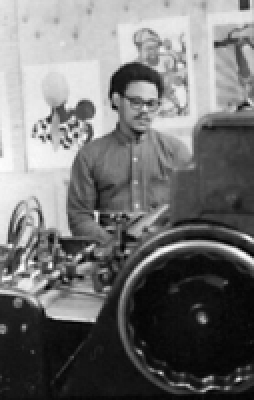
After arriving at the SF distribution office, I saw two old and incomplete "Chief 20" printing presses sitting side by side on the concrete floor. After examining them and discussing what was required to rebuild them, I decided to take on the challenge. I did not have any knowledge of the printing process but I did have the required mechanical skills to do a rebuild of the presses. I got help from an individual at the office - I remember his name being Ken, or Kenneth - who understood how printing presses operate. A few months later with one machine used for spare parts, the rebuild was complete. One functional "Chief 20" 14x20 printing press was up and running. After receiving a few lessons on the basics of printing, I was left on my own to develop my printing skills. Emory Douglas also provided me with valuable artistic guidance and proper artistic layout etiquette. My printing skills gradually developed over time as the press was used to print flyers, posters, pamphlets, restaurant menus, and business cards.
Around 1971 they moved to Oakland, where the print shop expanded with the acquisition of tabletop A.B. Dick duplicator, a litho plate burner, a guillotine paper cutter, and darkroom camera built by Benny. A Heidelberg KORD had been donated to the BPP, possibly from supporters in Chicago, but never ran because the shop lacked wiring for three-phase electric power. Press operator Steve Long describes the shop:
For a brief time we were on 79th and MacArthur, but soon moved to the back of 8501 East 14th Street (now International Boulevard) in Oakland, in a building now owned by Allen Temple Baptist Church. Phoebe Allen and I were Benny Harris' helpers/apprentices. Benny knew the press inside and out and was able to fix any and all problems. We printed almost all of the campaign literature for the Bobby Seale for Mayor and Elaine Brown's campaign as well. When Benny left the Party, Phoebe became the head operator because she had the most training. It was a particularly difficult task for her, as she was raising twin girls. When she left the party, I was left to run the press. During the latter days of the party, we sold some of our old presses, including the Chief and KORD, and purchased a Multilith 1250LW which printed 11 1/8” x 18 3/16”. (“It cost less to operate and was easier for an untrained person to learn,” adds Bennie). We were still printing largely Party material and materials for Oakland Community School, but began doing more commercial work.
Black
Sheep Press
San Francisco, 1967-2003; offset and
screenprinting
Originally called NormAl Printing, from partners Norm (unknown surname) and Allen Schaaf who started the business. Black Sheep was an independent and idiosyncratic union shop (proudly member of two unions, actually; affiliated with both the Lithographers and Photoengravers International Union and the Industrial Workers of the World). Following the deaths of the shop's founders in the early 1990s, ownership was taken over by Pamela Waldow-Shalala who had started as an employee and continued in the politically progressive traditions of the founders. The shop closed its doors in 2003 following a decline in business and several costly relocations. Grendl Löfkvist, the only remaining employee, went on to work as a press operator at Inkworks Press in Berkeley.
Chicano Art Center
Berkeley, 1970-1974; screenprint
This workshop was an off-campus facility hosted by the University of California and directed by Malaquias Montoya, then a part-time lecturer in Chicano Studies. Montoya recalls:
“We spent the first quarter at Berkeley preparing the studio, which was just an empty loft – we built tables, screen frames, exposure units. I would go ask local community groups what their upcoming publicity needs were, then I’d use those as assignments for the more advanced students who would also teach the newer students. After the first three weeks, when I gave lectures and brought in guest speakers, I alllowed students to come in very flexible hours. During that time I was still doing a community workshop for kids off the street and students at Laney College in Fruitvale on Saturday mornings, and I remember that when I’d buy supplies for U.C. Berkeley I’d add in something for the community workshop in Oakland.”
Chubasco Press
Oakland, 1983-1989; offset
Chubasco (named after a violent Central American coastal rain squall) was set up to support the Nicaraguan revolution by funneling proceeds from the "business" part of the operation into solidarity work with the FSLN. It was run by former schoolteacher and labor organizer Scott Wildman, who later became Glendale’s California State Assemblyman. The shop closed when the press was damaged during the Loma Prieta earthquake and concrete fell from the ceiling.
The
Community Asian Art & Media Project (CAAMP)
Oakland, 1979-1980; screenprinting
One of the many Bay Area arts projects fueled by public funding from CETA (the Comprehensive Employment and training Act), CAAMP was set up with help from Japantown Art and Media.
Return to top of directory
Double-H
Press
San Francisco, 1967-1967; offset
Little is known about this short-lived union shop (LPIU bug #72) that produced posters and poetry books (Preparation for a Death Trip, by Goodman Gries).
East Bay Media (also known as East Bay Media
Center)
Berkeley, 1971-1975; screenprint and offset
Doug Lawler started East Bay Media (EBM) in the spring of 1970 as a nonsectarian radical media service for progressive organizations. EBM created original poster art and offered production services to groups including KPFA, the Black Panther Party, and the underground newspaper Berkeley Tribe. Lawler recalls, “We pretty much helped everybody that came to us.”
At first it was just Lawler operating out of a small garage on Regent Street in Berkeley (one block up from Telegraph Avenue), using salvaged and donated equipment. The shop facilities were pretty minimal; they had to go to a nearby gas station to use a bathroom. Soon a collective was formed that included Peggy White, Harold Luckey, Stephanie Jones, Suzanne Korey, and many others. When the Berkeley Tribe folded in 1972 EBM moved into their storefront on Grove Street (now Martin Luther King Jr. Way, next to David Lance Goines’s current printshop). There they inherited a darkroom and light tables and soon bought a Chief 20 offset press they installed in a garage on California Street to produce leaflets and offset posters. Many of them lived together in a collective household on Grant Street in Berkeley. The group continued to work for local actions, including the United Farm Workers and independent theater groups. They also briefly served as a jobs program for ex-offenders released from Folsom Prison. The collective grew to around fifteen people, with approximately seven of the core group living in the communal household.
One participant and supporter was veteran artist Frank Rowe, who was teaching a course at Laney College called “The History of Art as Protest.” Some of his students worked with EBM, as did Frank himself, although with a low profile since he had only recently recovered his teaching career after years of blacklisting for his refusal to sign the Levering Act “loyalty oath” on principle. He describes helping EBM get their posters up in public spaces:
I had a Chevrolet pickup truck with a camper on the back, and we used that as a posting place in Berkeley. We’d go out and buy canned milk, for paste, and have the buckets in the back of my truck, but the actual work of posting—because Berkeley had an ordinance against it—was done by other members of the team, and I drove the truck and acted as lookout usually when we’d go out at night.
Perhaps their most famous poster was “Bring the Monster Down” which was reproduced in multiple editions and sold for two dollars from their Grove Street offices, at rallies, and at the Print Mint on Telegraph Avenue. Sales of that poster helped to defray printing expenses and pay for the offset press. Work was generally created by an individual and produced collectively, never credited to a single artist and rarely even to EBM.
Eventually personal life changes coupled with declining activism after the end of the Vietnam War led to the dissolution of EBM in 1975.
Fireworks Graphics Collective
San Francisco Bay Area (no single location), circa
1972-1997
Fireworks Graphics Collective (FWGC, or Fireworks) was founded in the late 1970’s by Prairie Fire Organizing Committee, (PFOC) in the belief that art was essential to politics and to creating a culture of resistance. All the core members of FWGC were members of PFOC. Fireworks existed as a collective into the 1990s and was best known for designing and printing over 100 political posters that were carried in demonstrations or wheat-pasted on the sides of buildings.
Fireworks saw art as an organizing tool, commentary, and, in the case of street posters, a form of activism in itself. Its philosophy was that political art should be beautiful, or at least striking. At its best it should incite thought and provoke discussion, particularly about issues distorted by the corporate media.
Terry Forman was often the lead artist, but other artists and activists were included on many projects. Most posters were silkscreened by hand in workshops, although when the situation called for it large quantities were offset printed by Inkworks Press. In some cases, Fireworks set up portable screenprinting stations at rallies to produce shirts and posters.
About half of Fireworks art was published as FWGC or PFOC. The other half was produced in conjunction with organizations like the Puerto Rican MLN, the Committee in Solidarity with El Salvador, the Republic of New Africa, prisoner rights organizations, Women against Imperialism, and the Dyke March. Fireworks contributed to group exhibitions, collaborated on billboard “corrections,” built a two-acre anti-war installation at the Emeryville mudflats with other artists, and designed life-size street stencils. FWGC also helped design the journal Breakthrough.
For every project, the political or social message, artistic design, proper media and of course, cost, was discussed collectively with the group requesting the work. Afterward, there would be an assessment of the overall process and how well the project had met its goals.
Some posters spoke to the moment, such as stopping the KKK from marching in San Francisco or opposing apartheid in South Africa. But some also addressed long-term systemic problems, such as pointing out government repression and the need to resist it. FWGC produced many posters about the FBI and Federal Grand Juries in the early 1980s, when activists in the Puerto Rican independence and Black Liberation movements were being jailed for refusing to cooperate with federal grand juries. One of those posters, “Build a Wall of Resistance, Don’t talk to the FBI,” has been reprinted many times, used all over the country, and has helped build another generation of activists.
Although FWGC no longer exists as an organization, members are still actively engaged in political and artistic actions.
Return to top of directory
FITS
Printing
San Francisco, 1971-1978; offset
FITS started as a literary magazine in 1971, and after several of the founding members (several of whom had met during the Columbia student strike of 1968) went to San Francisco Community College to learn to print they became a movement shop. Beside the standard workhorses of a Multilith 1250 and AB Dick 360, they had a Chief 22” capable of serious poster and booklet work. What did the name FITS mean? Here’s the story from a founding member, Hilton Obenzinger:
The name . . . We sat around trying to come up with a name, frustrated. People's Press was taken, so what else? Finally, after one fruitless meeting someone exclaimed, "We're just having fits." Eureka. Then we decided to capitalize it to indicate the initials meant something - and we kept on changing what that meant: Force Imperialism To Strangle, Friends in The Struggle, Freaks in The Struggle, Fuck Imperialist . . . Well, you get the idea. But the first two were the most common. Then people asked, "But Fitz what?" And we all suddenly became Scots. We actually enjoyed the fact that, in a movement that tended to take itself too seriously, it actually didn't mean anything but made people think that it must mean something. Let them wonder!
Other members included Juan Fuentes, Leslie Gottesman, Katherine Knowles, Alan Senauke, Joe Stern, Pamela Forman (Pamela Reitman), Polly Parks, and Nancy Werner. FITS later became part of the San Francisco Printing Coop, see below.
Five Trees Press /
Peartree Press
San Francisco (1061 Folsom St); circa 1971
Kathy Walkup was a trained printer and book arts artist. During the late 1960s she worked at Boston’s movement shop New England Free Press, and in 1971 she moved to San Francisco. She soon joined up with four other tradeswomen and founded the fine press shop Five Trees Press. After a few years she and another member formed the trade print shop Peartree Press, claimed to be “the first San Francisco job shop since 1901 that was run by women.”
[source: Art and issues #3, “Interviews with artists,” Gwendolyn Penner, date unknown.]
Free Print Shop
San Francisco; circa 1968-1972;
offset
The Free Print Shop was a project of the Sutter Street Commune, one of many alternative live/work experiments in the countercultural Bay Area. The commune's founder brought his printing presses to San Francisco in the summer of 1968, inspired by two fellow Diggers who suggested a free publishing venture. A Chief 15 was installed in the basement of one of the communal homes, and all bindery was accomplished by hand. Over the next several years, the Free Print Shop published a variety of materials including flyers for other communal groups, for free services, ecology groups, free arts groups, and the occasional political protest. In the spring of 1969 the Sutter Street Commune began publishing a weekly intercommunal newspaper, Kaliflower, which served as an important “internal” medium for sharing news, ideas, and concerns.
[From the finding aid for Friends of Perfection Records (California Historical Society, North Baker Library)]
Free
Speech Movement press
See Berkeley Graphic Arts
Gonna
Rise Again Graphics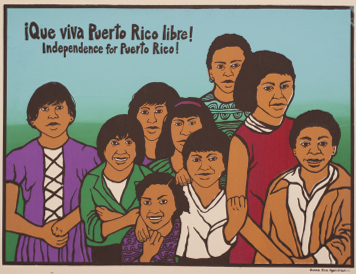
San Francisco, 1975-1978; offset &
design
Two members from the Noe Valley Silkscreen Collective joined up with two other local poster makers to form a design/printing political project with the specific purpose of supporting efforts to dismantle U.S. capitalism and imperialism. They wisely chose a collective structure but did not try to do all creative work that way. GRAG member Ron Weill put it this way:
"Since we agree art is a means to support a political movement, we have been freed from a lot of competitive feelings around, our work. The reasons for this are that we do work for social movement instead of for our own individual success and recognition. When people share goals, their successes are shared.’ In addition, he said, other members felt that their individual artwork (which they all continue to do) had been nourished by the support, criticism, and training they'd received in the collective.”
Graphic Arts of Marin
Sausalito; 1960-1993; typesetting and offset
Graphic Arts of Marin, Inc. was founded in 1960 by Allan Ross a Jewish immigrant from Russia, his wife Jane an immigrant from Quebec, in partnership with Bernard and Marie Moss. Their combined talents in typesetting, graphic design, proofing and printing as well as collective political activism drew together a shop of progressive people in the industry. All had been trade union organizers in New York and had come to the Bay Area seeking a less hostile political climate post McCarthy era 1950s. The union shop, though not formally a political press, was sympathetic and supportive home for a wide range of left, labor, movement, and counterculture publishing. GAM printed calendars for the Graphic Arts Workshop as well as many posters, including campaign posters for Berkeley’s Bill Miller, and rock posters for Victor Moscoso.
GAM also printed some of Emory Douglas’ posters for the Black Panther Party and was the first publisher of The Black Scholar. In 1969 Nathan Hare, recently fired from San Francisco State College, joined with GAM’s Allan Ross and fellow fired SFSC faculty member Robert Chrisman to launch the groundbreaking independent black scholarly journal. Additionally, Allan and Jane Ross launched Books Behind Bars, a free book program for those incarcerated in the U.S. active in the 1970s.
Graphic Arts Workshop
San Francisco; ~1952-present; screenprint, relief, and intaglio, and
lithographic printing.
Originally a range of classes operating under the umbrella of the Communist Party’s California Labor School, the Graphic Arts Workshop (GAW) became a separate entity sometime between 1949 and 1952 when conservative political pressure and the loss of their nonprofit status closed down the School. The lithography and etching presses were moved out, and they continued working in a long sequence of locations - 141 Valencia Street, 271 Francisco Street, 359 Waller Street, 6253 California Street, and finally 2565 3rd Street. Some of the artists included Stanley Koppel, Alice Gibbons, Pele deLappe, Richard Correll, Larry Yamamoto, Irving Fromer, Frank Rowe, Louise Gilbert, Victor Arnautoff, Bits Hayden, William Wolff, Frank Cieciorka, and Emmy Lou Packard.
Poster making was a minor
activity at the GAW – the majority of works produced were fin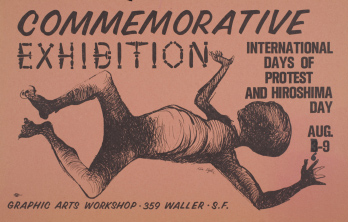 e
art prints, but members also made paintings and murals.Following the
model of Mexico’s Taller de Gráfica Popular, both individual and
collaborative projects (such as commissions and exhibitions) were
encouraged. Although most of the original members were quite political
and believed in the role of socially engaged cultural work, they also
were acutely aware of the political risk that public political art
entailed in the 1950s. Consequently, little of their printmaking for
public distribution could be described as militant or agitational by
the standards of the late 1960s. General themes of peace,
antidiscrimination, or labor dignity appeared from time to time, but as
an institution their radicalism took other forms. When the democratic
and multiracial Marine Cooks & Stewards Union was under attack in
the late 1950s, the GAW helped out with a series of displays. The
union's headquarters had four 13’x7’ bays; GAW filled them first with a
Black History exhibition, then with ones on Mexican-American heritage,
women in the labor movement. They also regularly produced posters for
Black History Week and for civil rights groups such as the Committee
for the Protection of the Foreign Born.
e
art prints, but members also made paintings and murals.Following the
model of Mexico’s Taller de Gráfica Popular, both individual and
collaborative projects (such as commissions and exhibitions) were
encouraged. Although most of the original members were quite political
and believed in the role of socially engaged cultural work, they also
were acutely aware of the political risk that public political art
entailed in the 1950s. Consequently, little of their printmaking for
public distribution could be described as militant or agitational by
the standards of the late 1960s. General themes of peace,
antidiscrimination, or labor dignity appeared from time to time, but as
an institution their radicalism took other forms. When the democratic
and multiracial Marine Cooks & Stewards Union was under attack in
the late 1950s, the GAW helped out with a series of displays. The
union's headquarters had four 13’x7’ bays; GAW filled them first with a
Black History exhibition, then with ones on Mexican-American heritage,
women in the labor movement. They also regularly produced posters for
Black History Week and for civil rights groups such as the Committee
for the Protection of the Foreign Born.
Starting in 1954 and continuing through the early 1970s they produced an art calendar. According to Irving Fromer “This was what paid our rent; we sold about a thousand a year."
Over the years many of the artists coming in were less political than the core group of founding members. Also, pervasive anticommunism had cast a chilling effect on the GAW, and by the late 1960s their public output was distinctly less radical than that of the new generation of activist artists. Four younger art activists (including Rachael Romero, née Rachael Bell, later of the San Francisco Poster Brigade) joined the GAW, and produced experimental lithographs, portable murals, and other public events. This new grouping was seen as less politically disciplined, which did not sit well with some older members who were aligned with the Communist Party, U.S.A. The resulting tension within the GAW came to a head in 1974, when the new grouping was challenged on their activities. Founding member Stanley Koppel chaired a contentious two-day meeting at which the side supporting a lower profile, broad community front won out, and the by-laws of the organization were changed to remove politics. The new activist group got the message, and moved on to other venues.
Beside individual members visiting the other movement workshops that emerged starting in the 1960s and encouraging the emerging artists, there was little formal relationship between the GAW and the next generation of printmakers. However, several children of this arts community have continued the path of social justice cultural work, and the steadfast example set by the GAW during the oppressive 1950s served as a beachhead for subsequent poster workshops.
Greenleaf
Press
San Francisco; circa 1974-1984; offset
[The Democratic Workers Party was a Marxist-Leninist California organization under the leadership of Marlene Dixon. The DWP also participated in gay rights, feminist, and anti-racist work.]
The party developed its own print shop (first called Greenleaf Press, then Synthex Press), which grew into a full-service printing and publishing operation that serviced mainstream clients such as banks, catalog companies, and publishers throughout the San Francisco Bay Area. The press produced numerous materials for the Party: books, journals, newspapers, pamphlets, fliers, bulletins, direct mail solicitations and buttons among other things. The Party developed its own newspaper; the Rebel Worker (later known as Plain Speaking) along with theoretical journals such as Our Socialism.The DWP produced two academic journals, Contemporary Marxism and Crime and Social Justice, which solicited and published articles by well-known Leftist intellectuals.
(Text for this entry from Janja A. Lalich, Bounded Choice: True Believers and Charismatic Cults, Berkeley and Los Angeles: University of California Press, 2004.)Inkworks
Press
Oakland/Berkeley, 1974-2016; offset and
design
In 1974 several founders, who had been learning offset printing at an alternative school, embarked on creating a movement print shop. The various streams of activism – against the Vietnam War, for international solidarity, civil rights, feminism, LGBT rights – were in full bloom, and there was a deep need for community-based media facilities. From the beginning, the shop planned to be self-sufficient, which would be accomplished with a blend of commercial and political work charged on a sliding scale.
As a mechanism to institutionalize revolutionary politics, the shop became a non-profit (though not tax-exempt) corporation with a collective structure in which everyone owned it together – no one owned any individual share, as is the case with co-ops. Over the years, the collective has sought to be a model of ethnic and gender diversity, and many members came from other movement shops from around the country and Canada. In its early days the collective developed a Political Points of Unity to define where the shop stood and whom it served. Inkworks has tried to be an inclusive facility serving the broad progressive community. As a way to assure reasonable working conditions and align with the labor movement, Inkworks became a union shop (International Printing and Graphic Communications Union, now part of the Teamsters) in 1978.In addition to work that came in the door, Inkworks routinely engaged in publishing projects of its own. During the mid-1970s they produced a very popular monthly community calendar; other efforts included books, note cards, and posters.
Bridging such a long time span in a rapidly changing industry has involved significant risks and challenges, especially for an undercapitalized alternative shop. Inkworks was an early adopter of the then-new “desktop publishing” technology of the mid 1990s that opened the doors for ordinary citizens to set their own type (for better or for worse.) They embraced the huge shift from analog camerawork to digital imaging, and finally to digital, on-press full color offset printing and short run toner copying. Inkworks also was a pioneer in using more environmentally friendly inks, papers, and solvents.
Inkworks was one of a handful
of shops in the United States that continually
served the social justice community for over thirty years, the others
being Boston’s Red Sun Press and Chicago’s Salsedo Press.
Inkworks closed
its doors in 2016.
Japantown Art and Media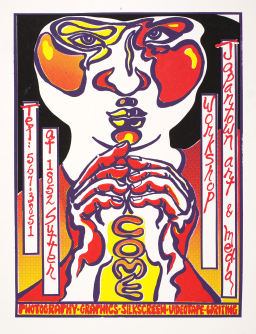
San Francisco, 1977-2000; screenprint and design
The Japantown Art and Media Workshop (JAM) began when the Kearny Street Workshop was in danger of collapsing. Many JAM organizers had been part of KSW, and they continued to produce through JAM's facilities. It proved a fertile resource for a whole generation of Asian-American artists. Like KSW, JAM actively engaged in political posters on issues affecting the community, such as reparations for WWII relocation camp internees. At its height JAM had up to five serigraphers on full-time (low) pay.
Jellyroll Press
Oakland/Berkeley, 1969 (one year); offset
Jellyroll Press was one of the first independent printers to take on counterculture printing that the straight shops didn’t or couldn’t do. In 1967 Thomas Morris and fellow UC Davis art program graduate Frank Carson, while still students at California College of Arts and Crafts, began designing promotional material for rock concerts. Soon their work expanded into doing the printing as well. Morris recalls:
I wish I could remember exactly how – but as our network of contacts grew, and more people reached out to us – I somehow was introduced to one my first mentors: Ken Oleari. Ken was a living vortex of unending energy and was in touch with a whole segment of a creative subculture that I was unaware existed. He brought me in touch with a circle of Berkeley “intellectuals” who had used some incredibly resourceful (if not somewhat dubious) methods to get funds together to buy, and build a print shop in the heart of the Oakland ghetto. The group had become disenchanted with the prospect of actually getting ink on their fingers or doing real work – and simply gave over the entire space to us if we just paid the rent. So, in a matter of weeks, Ken and I studied manuals on printing, and quickly learned how to become offset printers on an old 24 inch single-color Harris machine that had been designed to fit on the back of truck and on battleships (in wartime) for printing maps and documents. Ken introduced me to the early Digger collective, into which I became immersed in a lifelong relationship with as we began printing the first generations of Peter Berg’s Planet Drum manifestos.
By 1969 Morris, Ken and his Digger friends had become completely committed to running a “free” print shop in that funky warehouse on the Berkeley-Oakland border, and had chosen the moniker Jellyroll Press – For Do Wah Diddy and New World Stuff. Morris also used this resource to bring in revenue by designing and printing rock posters when the presses weren’t busy pumping out controversial media. Morris recalls one incident:
One night, just as I finished cleaning the press, the hair on my arms actually began to rise off the skin, and the air smelled electric. Opening the door into the rest of the old warehouse, I spotted flames in the back of the building. Looking into this incredible shop that we had built out of nothing, I grabbed the only possession that I cherished at the time, my leather coat, and made it to the front door on my hands and knees under the smoke, just as the fireman’s axe came crashing through the door. Word spread quickly (we had two communal houses nearby), and my friends all gathered, as we watched the building burn to the ground.
Discouraged, but not undaunted, we moved the equipment into a storefront on old Grove Street (a few doors down from the Black Panther headquarters), and began peeling back the melted rubber and rust. The hidden storefront was a part of the building that we (the Diggers) had just converted into the “free” bakery, with donated commercial equipment – baking free bread to give away to the community. As the printing press restoration neared completion, we were approached by a women’s collective (buzz word of the day) who proclaimed that they were “liberating” the machine. It was their turn to unleash the magic and power of that printing press. I believe it ended up in a building filled with poetry groups near the Ashby BART station.
The small Multi 1250 remained in the storefront area at that location, where it was used for many small-press formatted posters, booklets, and leaflets. Eventually, all of the equipment was given away, and Morris traveled from Mendocino to San Diego, assisting and training in offset printing, and working with media groups.
Return to top of directory
Jungle Press
San Francisco, ~1975-1980; offset and typesetting
An early women-owned and operated press, Jungle started out as a community commercial shop and later added a publishing division, producing small books, poetry, and posters on feminist heroines and issues. They were very involved in the small press community, producing work for antiwar groups, artists, and the San Francisco Mime Troupe. They were a union shop (Allied bug #64), which allowed them to print for the United Farm Workers who had a nearby office and were then involved in a major campaign. Jungle also worked closely with a letterpress shop, Five Trees Press, eventually sharing the same facilities.
Kearny Street Workshop
San Francisco, 1972-present; screenprinting
Kearny Street Workshop is the oldest multidisciplinary Asian American arts organization in the United States, and the second (after La Raza Silkscreen) significant Bay Area poster workshop of the 1970s. In 1972 Jim Dong, Lora Foo, and Mike Chin founded KSW with funds from the National Endowment for the Arts, the San Francisco Neighborhood Arts Program, and the Chinatown-North Beach Youth Council. There were many local political battles that drew artists, and KSW was in the middle of campaigns around the International Hotel and strikes by garment and electrical union workers. Despite numerous difficulties in finding funding and a permanent home, KSW has been a vital training ground and network for the Asian community's young artists. One of their most powerful projects involved pairing a poet and a graphic artist, resulting in rich collaborative works.
La Raza Silkscreen Center / La Raza Graphics Center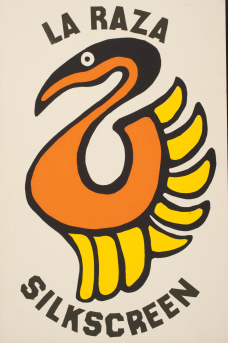
San Francisco, 1971-1974 (LRSC),
1974-1995 (LRGC); screenprint, offset, design
(First located at 3174 16th St., then at 938 Valencia St.)
One of the most prolific and influential poster centers of the Bay Area, LRSC/LRGC served not only as a cultural hub in San Francisco’s Mission District, it attracted artists from all over the world.
The first posters came out of a predecessor organization, the nonprofit La Raza Information Center about the case of “Los Siete de la Raza.” In 1969 an altercation in the Mission District between two plainclothes S.F. police and seven young Latinos resulted in one officer dead. During the subsequent year and a half long trial, movement groups supported the defendants on the grounds that the S.F. police had long been engaged in harassment toward people of color and youth, and that this trial was part of a pattern of racist persecution.
The
first directors of LRSC were Al Borvice, Oscar Melara, and Pete
Gallegos, with the help of Eileen Starr and Michael “Mike” Rios. Actual
poster production was often collaborative, with one person doing the
design and others doing the printing. Individual credit rarely appeared
on any work. A large number of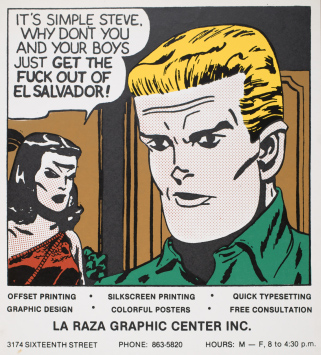 neighborhood youth participated in
the free or cheap classes.
neighborhood youth participated in
the free or cheap classes.
Many who cut their teeth in this vibrant project – such as Linda Lucero, Herbert Sigüenza, Rayvan Gonzales, Juan Fuentes, Jos Sances, and Kate Connell – went on to work as successful community artists. As was typical of many of the community-based workshops, financial support was always a challenge. Pete Gallegos put it this way, reflecting on the potential grant money they never got:
It was a mistake, maybe. But we figured out our own way of making money – nobody got paid! [But] it was a beautiful way to operate, without envy or jealousy, or leadership struggles – the work was there to be done, one just had to do it with discipline, and do it well.”
It was not uncommon for a visiting printmaker from Chile, or South Africa, or Cuba, or the Philippines to spend several days learning and teaching with other local artists. Also, there were many other cultural activists in the same building and nearby, and synergistic collaborations abounded.
LRGC bought an offset press in 1981 to expand their poster production, but they never really developed the technical infrastructure or expertise to make it viable, and focused its efforts on graphic design. In 1995 LRGC was absorbed into the Mission Cultural Center for Latino Arts.
The Media Project
Oakland/Berkeley, 1969-1971; screenprint
The Media Project started out at Oakland’s California College of Arts and Crafts (CCAC) as one of the many spontaneous student responses to the shootings at Kent and Jackson state colleges, as well as the invasion of Cambodia, and was committed to producing agitational and educational materials for the movement. Member Jeff Schuerholz remembers the scene during the first four months that they operated from CCAC:
I didn't go home for four or five days. It was an exciting time. In the beginning of summer we erected a billboard on the southern edge of campus. It faced the street. It had some kind of peace message on it, and someone fired a few shots at the campus from a passing car. In the beginning there were hundreds of us. People from the community brought us food and supplies. We worked long hours every single day… Eventually we claimed two buildings on campus. One was mostly silkscreening and the other was silkscreening, meetings, and office. Our phone rang constantly…The Media Project became the clearinghouse for the political happenings in the area.
In addition to posters, the group engaged in a wide variety of street theater, billboard alterations, and public happenings. Among its members were Bruce Perry and Peter Kimmel, as well as Bruce and Ellen Kaiper and Gary Lapow, seasoned veterans of Civil Rights and social justice campaigns. The collective produced a wide range of materials for the Indian occupation of Alcatraz, Los Siete de la Raza, film showings, local progressive ballot measures, and antiwar projects. They soon moved off campus to a collective on Stuart Street in Berkeley to pursue their work. Eventually, divergence of political interests and difficulty in sustaining the collective household led to the Project’s dissolution. People went their separate ways, but many continued as activists. Lapow went on to form the activist local musical group Red Star Singers, a regular presence in many political actions, and Schuerholz became a street activist member of ACTUP LA (The AIDS Coalition to Unleash Power) and also Queer Nation Los Angeles.
Return to top of directory
Mission Gráfica
San Francisco, 1980-present; screenprint
Founded by Rene Castro and Jos Sances in 1982, Mission Gráfica filled a void left by the collapse of the Mission Cultural Center’s Graphics Department and the reorganization of La Raza Silkscreen Center into primarily an offset shop, which was renamed La Raza Graphics. In 1980 Sances, with years of commercial printing experience behind him and jobs at LRSC and in Concord, California, at Nelson Screen Printing (a commercial shop), he took a class funded by the CETA program and taught by Castro at the Mission Cultural Center. Castro was a Chilean exile who had been imprisoned and tortured for two years by the Pinochet regime. Sances was from a Sicilian working-class family in Boston and, after deserting from the U.S. Navy during the Vietnam War, had moved to the Bay Area in 1978.
From 1980 to 1982 the two worked together on specific projects and slowly began to assemble the equipment needed to outfit a fully functioning screenprint shop. By 1983 they had formed Mission Gráfica, where together they worked fulltime as printers and teachers.
Known for vibrant color, bold text and artistic excellence, the posters produced at Gráfica were intended to serve the community. Much of the work was done for free or at a discount, and artists other than Castro and Sances were encouraged to participate in the production of their designs. The shop also turned out purely commercial work, including posters for events, exhibitions, and performances.
Their reputation for high quality work and exceptional artistic design made them a community favorite with the myriad political and solidarity groups in San Francisco’s Mission District. Their commitment to liberation struggles, ecology, the anti-nuclear movement, disarmament, and other local and grass roots community issues and organizations combined with the eclecticism of their work to make them totally unique.
Michael Rossman called Mission Gráfica “the epitome of the social serigraphy movement itself, which has been dedicated to the most local service, yet internationalist in perspective; intensely ethnic in focus, yet inter-racial in cooperation.” Rossman estimated that by 1986 the shop had produced five hundred multicolor designs, at least three per week, with the aid of an automatic press they were able to purchase, “while [Gráfica’s] artists developed technical mastery...and complex, distinctive styles...integrat[ing] elements from many graphic streams and reflect[ing] the rich diversity of the multi-ethnic community” they served.
Castro and Sances maintained a welcoming environment for artists and activist printmakers, and many international and local artists used the facility to produce posters and fine art prints. Among those who produced work and participated in the production at Gráfica in the early years are: Tirso Gonzales, Enrique Chagoya, Nancy Hom, Rupert Garcia, Ester Hernandez, Carmen Lomas Garza, and Nina Fichter (of the Dance Brigade). Artists came from Argentina, Mexico, Nicaragua, Brazil, Chile, Costa Rica, and Cuba, as well as Europe. Calixto Robles discovered Gráfica in 1986 and remembers it as a “place full of prints that filled several racks in the studio, with different images, some of them announcing a benefit for a social or political cause in the Mission, a poster for a Santana concert in Berkeley, or a business sign for a store in the neighborhood.”
Castro and Sances made posters for Bill Graham and a number of musicians he brought to the Bay Area, including U2, Rubén Blades, Carlos Santana, and Willie Colón. Feeling that these associations were a distraction from the work he wanted to do, Sances left Mission Gráfica to set up a shop in Berkeley in 1988. There he shared space with Scott Braley and the Fireworks Graphics Collective for several years.
In 1990 Calixto Robles, a Mexican printmaker originally from Oaxaca, began to volunteer at Gráfica, under Castro’s direction, and in 1992 he became Castro’s assistant. During this time Patricia Rodriguez, Yolanda Lopez and Ralfka Gonzalez produced a portfolio of posters. Some time later, when Mission Gráfica rented a Griffin etching press from Bolivian printmaker Flavio Ayala, etching classes were offered at the center and taught by Ayala. Alexandra Blum introduced a monoprint class in 1997 and taught it until 2006, when Russell Pachman took it over.In December 1994, Castro left Gráfica for a one-year trip to Latin America, leaving Robles in charge. The Mission Cultural Center didn’t rehire Castro on his return, so, in his own words, “I stayed on, producing works and teaching, with the support of several artists, including: ArnoldoX, Sharon Shawn, and Gonzalo Hidalgo. We offered free linocut and wood carving classes to high school students, as part of the after school program.”
Mission Gráfica entered a tumultuous time in the mid-1990s. Juan Fuentes remembers:
In 1996 or 1997 Calixto Robles invited me, along with other artists, to a meeting in the Mission to discuss the state of Mission Gráfica. Rene Castro had taken some time off and returned to find he had been removed from his position as director of Mission Gráfica. It was a very unsettling time at the Mission Cultural Center. Internal political struggles resulted in the board of directors taking over the management of the center. They had closed Mission Gráfica, and artists from the community demanded it be reopened. La Raza Graphics Center had moved into the MCC, only to disband shortly thereafter.
When master Chicano printer Fuentes took over the directorship of Mission Gráfica in 1997, the production of posters had significantly decreased. Many of the political and community organizations of the 70s and 80s were gone, and many could not afford the high cost of producing posters. With the rise of the new electronic media, it was cheaper for these organizations to do the work in-house on their personal computers. In response to the decline of screenprinting and the rise of material and labor costs, Mission Gráfica transformed itself into a printmaking studio with a strong educational component. Classes were offered through Horace Mann Middle School and Drew Preparatory High School, and there was a free drop-in class for high school students. Along with these classes Gráfica also offered classes in monoprint, etching, relief and screenprinting for adults. The other significant change was the use of water-based inks for posters and classes, a more people-friendly medium and much safer for youth.
Calixto Robles worked alongside Fuentes, teaching as well as producing community posters and prints to promote the center’s programming. Several screenprint portfolios were produced, including collaborations with artists and poets, and a print portfolio of nine women titled “Nueve Mujeres.”
Many screenprinters and collectives had roots at Mission Gráfica. The San Francisco Print Collective addressed issues of housing, homelessness, and gentrification, and Talleres Populares 28 de Junio, El Caracol de la Mission, and Collectivo de Gráfica Villa-Zapata first worked at the taller. Jesús Barraza is a notable example of the kind of artist who took screenprinting classes at Gráfica and went on to found his or her own shop.
Juan Fuentes and his coworkers initiated a gallery at Mission Gráfica, “Galeria Zapatista,” to showcase Mission artists and to support the struggles of the Zapatistas and the people of Oaxaca. Juan Fuentes also organized two major exhibitions focusing on the work of Mission Gráfica. The first was for MCCLA’s twenty-fifth anniversary. Drawn from the wealth of subject matter the workshop addressed over the years—issues relevant to Native Americans, Latin Americans, and the local and international community—more than seventy-five posters filled the gallery demonstrating Grafica’s vibrancy and devotion to the movement and the community. The second exhibition, in 2006, was part of the Chicano Visions exhibit at the de Young Museum. The Mission Gráfica component, “Chicano Encounters,” centered on the culture within San Francisco’s Mission District, addressing issues of identity and social and political struggles within a global context.
Fuentes left his position as director of Mission Gráfica in 2007. Marsha Shaw is now coordinator, and Calixto Robles, after two decades of commitment, continues to teach screenprinting classes at Mission Gráfica.
Mission Grafica text provided by Jos Sances, Robbin Henderson, Juan Fuentes, and Calixto Robles.
New Americas Press
(aka Popular Press, Solidarity
Publications)
San Francisco, 1981-1985, offset
Popular Press grew out of Adam Kufeld’s solidarity work for the El Salvadoran Popular Revolutionary Bloque through Casa El Salvador “Farabundo Martí” in a small San Francisco Mission District storefront. Casa El Salvador had been using a mimeograph machine to make leaflets and flyers, but soon realized it was not up to the task. They bought a Multilith 1250 and asked Marlene Tobias, who had her own small shop, to teach Adam how to print. In 1984 they became the "commercial movement print shop" Popular Press. With their mighty Chief 22 and support from other local movement shops they added a publishing division, Solidarity Publications, and produced the report on the El Mozote Massacre several years before the NY Times did. Around 1984 they adopted a more “mass” name and became New Americas Press, continuing to publish full-length books on El Salvador and Central America as well as shorter interviews. The next year a suspicious fire broke out and the shop ceased operation. Kufeld remembers some of the work:
“We were mobilizing for a particularly large and important demo. Kissinger was coming to town and we really want to “welcome” him. So, we decide we needed 25,000 fliers for the Bay Area. That’s a lot of fliers on two twenty-year old presses. And we decided it needed to be two colors, for impact. Well, long story short, in our stupor of printing day and night we forgot to unmask the date and time of the demo. And, well we were just going to have to run them all back though again, another 25,000 times, now that’s 75,000 impressions, in printers terms. It’s sort of funny now, but then, well it was less funny. But everyone pitched in, and we did it…”
New Earth Press
Berkeley, ~1993-1995; offset
Ben Clarke and Clifton Ross founded this small shop in a storefront across from the Ashby BART station as part of their publishing work on the Zapatista movement and other Latin American and Central American solidarity projects.
Return to top of directory
Noe Valley Silkscreen Collective
San Francisco, 1972-~1974, screenprint
A collectively run screenprint workshop that produced independent and commissioned work.
Noh Directions Press
Berkeley; 1968-1969; offset
Poets
John Oliver Simon and Richard Krech became partners in this small
commercial printing shop where they handled outside work to support
themselves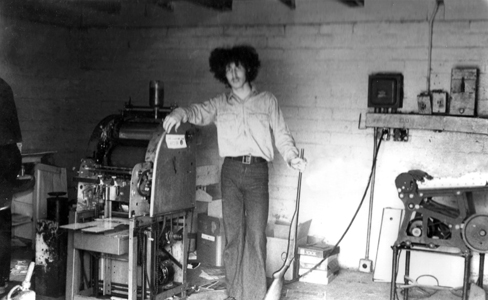 as well as their poetry. Much of their publishing as Undermine Press
was printed at Noh Directions Press on an old A.B. Dick 360 offset
press. Krech describes the genesis:
as well as their poetry. Much of their publishing as Undermine Press
was printed at Noh Directions Press on an old A.B. Dick 360 offset
press. Krech describes the genesis:
We drove John's van to Sacramento sometime in 1968 (I think) and picked up the A.B. Dick 360 from a garage. We took it to "the boneyard" at Fifth and Delaware, now near the heart of Berkeley’s yupped-up Fourth Street shopping district. Many important documents were produced there, including The Berkeley Liberation Program as a slim chapbook written by some Weather people, among others, plus Tom Hayden; The Grass Prophet Review; "the White Ghost of Bobby Hutton”; the Telegraph Avenue Liberation Front manual (“socialism on one street corner”); the San Francisco Express Times (Telegraph Avenue Edition), posters, and more.
John
later briefly moved the press named “Edna” to a garage on Allston Way
where it was used to print Aldebaran Review and Galactic Approximations
Press titles. Noh Directions was a union shop, affiliated with the
Industrial Workers of the World (I.W.W.). Around 1969 it went to the
Oakland garage of John’s ex-wife, Alta Gerrey, who started Shameless
Hussy Press and where she printed the first edition of Ntozake Shange's
For Colored Girls Who Have Considered Suicide When the
Rainbow is Enuf.
[Photo: Richard Krech, "Edna," and a .410 shotgun, at the
boneyard, 1968. Photo by Harold Adler, all rights reserved.]
Orbit Graphic Arts
San Francisco, ~1963-1974, offset
Run by Hal Kramer, Orbit had a large two-color press that ran many early counterculture and political posters, including work of the artist Satty.
Peoples Press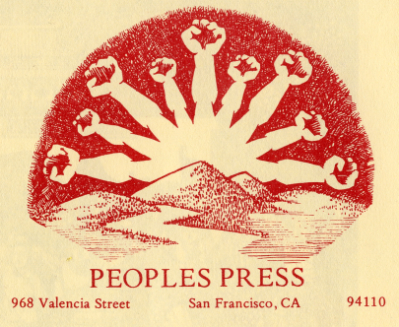
San Francisco, 1969-~1977; offset
In 1969 three underground press activists – Terry Cannon, Frank Cieciorka, and Robert Gabriner- embarked on building a publishing house for movement materials, and they produced a series of popular primers: The Black Panther Primer,Vietnam, a thousand years of struggle, and The Ecology Primer. In the beginning they relied on other local shops for actual production, but as the collective expanded they set up a print shop at 968 Valencia Street with a Multilith 1250 and a Chief 22”. As collective member Marty Williams explained:
I don't remember which of the guys scored the press, but no one knew how to print. Jane Norling and I taught ourselves how to print by going down to the Howard street lofts to watch the fellow who had the anarchist print shop there. After several days of observing, he let us try it out under his supervision. We went back and got the Multilith 1250 going (Jane and I), using the Navy Manual as our guide. Frank C. ran the darkroom, but soon Jane and others were doing a lot of the prep work and I was printing with Ksiel Stzundel on the Multi. Then we got the 22" press I used and Peter Rubin printed with me for a while.
In 1970 they organized themselves as a collective, with a deliberate balance of men and women’s leadership; among the new members were Gail Dolgin, Jane Norling, and Marty Williams. Others soon joined, including Ksiel Stzundel, Peter Rubin, Harvey Bender, Terry Karl, Susan Adelman, Penny Johnson, and Linda John, to work on specific publishing projects and/or in designing and printing community flyers, posters and small books.
In the fall of 1973 the Peoples Press collective was considering disbanding and/or reorganizing; they felt that their equipment and skills were not being fully used at the time when the movement clearly needed more propaganda. Williams:
I think we were feeling that running a viable print shop required a skilled and full-time staff. We did not have the skill level nor the financial foundation to continue at the level where we were doing some community printing here and there and then working in small groups on larger, more ambitious political publishing projects. We did not have a core of people who wanted to be full time printers for profit or as a non-profit and we decided to focus on publishing larger, significant projects and work on distribution of both our titles and those by others.
They initiated discussions with other community stakeholders, including FITS Printing and the Union of Democratic Filipinos (KDP). In 1974 this movement merger formed the San Francisco Printing Coop, but Peoples Press soon stopped printing and production to pursue publishing, and moved to 21st and York where they shared an office with Gonna Rise Again Graphics. Their presses were turned over to FITS Printing.
At times the collective and project-specific participants included as many as 25 people. They were responsible for numerous books and pamphlets on international political struggles; in 1977 their Palestine Book Project published Our roots are still alive: the story of the Palestinian people, and other titles were released by the Angola Book Project and the Puerto Rico Project. They also produced a North American quarterly edition of the Cuban magazine Tricontinental published by OSPAAAL.
Popular Press
See New Americas
Press
Rainbow Zenith
Berkeley; ~1969-1971; offset, screenprint, letterpress,
& typesetting
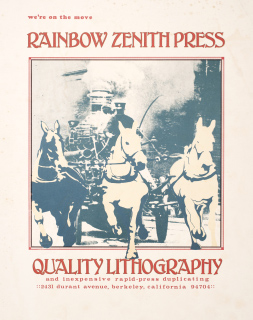
Located in a mini-mall walkway between Durant and Bancroft streets near the U.C. Berkeley campus, Rainbow Zenith began as just another “instant print shop” but soon developed pacifist tendencies through the encouragement of its workers. The shop was used by many campus and community activist organizations to print posters and other propaganda because they were one of the few with a large-format press (22” Harris) as well as Multilith 1250 duplicators. It started out as Gnomon Copy Service, the West Coast branch of the first U.S. photocopy shop that had started near Harvard University in Cambridge, MA. The Xerox production photocopier was used extensively for quick political messaging. They became a union shop when they changed hands under Michael Johnston and became Rainbow Zenith. Poster artist Thomas Morris teamed up with press operator Greg Robb (after fire destroyed his Jellyroll Press) and convinced the shop owner to allow them to print rock posters and counter-culture collateral materials after hours and on weekends when the shop was closed.
Royal Chicano Air Force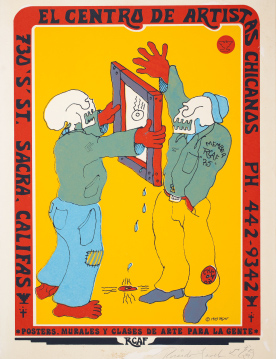
Sacramento; 1969-~present, screenprint
Although not technically a Bay Area workshop, many of the posters produced by the RCAF were displayed around the state and were a strong influence in early Chicano printmaking. Initially called the Rebel Chicano Art Front, the initials confused some who mistook it for the Royal Canadian Air Force, so the organizers whimsically changed their name. Founding members included José Montoya, Esteban Villa, Juanishi V. Orosco, Ricardo Favela, and Rudy Cuellar. The RCAF was a bilingual, community-based organizing project whose cultural forms included posters, prints, murals, music, poetry, and theater.
San
Francisco Community Press
San Francisco; circa 1967-1973
San Francisco Print Collective
San Francisco, 2000-present; screenprint
The San Francisco Print Collective (SFPC) started in 2000 when a group of silkscreen artists met at Mission Grafica to create agitational posters about the gentrification displacement of low-income people and immigrants in the Mission district. They soon aligned themselves with a local community-based organization (the Mission Anti-displacement Coalition) and participated in several media campaigns that aggressively used public spaces to promote their message. Posters were wheatpasted and placards were distributed at rallies; mainstream media coverage greatly multiplied the visibility of the campaign. Subsequent issues have included homelessness, military spending, police misconduct, and laws unfairly targeting poor people.
Other visual approaches include large-scale image projections on city buildings (one such event was a collaboration with a local war tax resistance organization at the West Oakland Post Office that reached BART commuters, evening car traffic and last minute tax-filers) and a four-part banner series at City Lights Books, which ran from 2001 to 2006 and encouraged dissent in the post-9/11 era while providing commentary on current events, government misinformation and the corporate media. Since 2000 their repertoire has included billboard liberation/correction, subverting commercial and mainstream political messages in public spaces. These include replacement bus shelter ads that reach large numbers of people on the street. They also create temporary and portable murals with community organizations. Examples include a Mission District/Clarion Alley critique of gentrification in 2008 and a project in 2005 they worked with native California tribes to create a giant graphic and text piece about the expansion of Shasta Dam.
The SFPC also offers low-cost screenprinting workshops for community activists and encourages collaboration between artist and neighborhood organizations. They operate as a loosely organized collective.
San Francisco Printing Coop
San Francisco, 1974-~1978; offset, design
Located
at 968 Valencia Street, the San Francisco Printing Coop was formed in
1974 by the strategic political alliance of People’s Press, FITS
Printing, and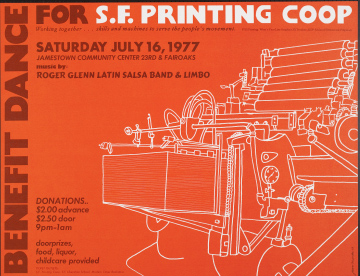 the Union of Democratic Filipinos (KDP); the next year they were joined
by Up Press and What’s Your Line Typesetters (formerly the Co-op
Typesetting Collective). Other political partners included the Northern
California Alliance, the Puerto Rican Socialist Party, the
International Indian Treaty Council, and El Tecolote newspaper.
It was an ambitious effort to transcend the sectarianism and
splintering that was pervasive in Left organizations at the time. The
goal was to be an efficient media hub for the movement. In their own
words:
the Union of Democratic Filipinos (KDP); the next year they were joined
by Up Press and What’s Your Line Typesetters (formerly the Co-op
Typesetting Collective). Other political partners included the Northern
California Alliance, the Puerto Rican Socialist Party, the
International Indian Treaty Council, and El Tecolote newspaper.
It was an ambitious effort to transcend the sectarianism and
splintering that was pervasive in Left organizations at the time. The
goal was to be an efficient media hub for the movement. In their own
words:
“The cooperative, as a political form for organizing limited movement resources, has certain strengths: It makes possible a continuity and use of equipment and skills by and in the movement which was not accessible at a lower stage when these resources were scattered or limited in their use. As a political form, the cooperative can clarify areas of legitimate autonomy and areas of legitimate unity on the part of its members. It makes the cooperativization of production possible…Concretely, in our case, it has meant that the three main areas of propaganda – writing, production, and distribution – can be carried on in less isolation from each other than before.”
Sequoyah Graphics
Oakland, 1980-2010; offset
One month after Ithaca’s Glad Day Press closed December of 1979, core members Al Ferrari and Arlene Southern arrived at the Liberation Support Movement office in Oakland to continue similar solidarity work. They soon started Sequoyah Graphics, a primarily commercial shop that regularly supported progressive activities. In addition to printing materials for groups for free or at discounted rates, Sequoyah also engaged in such activities as the US-Nicaragua Printers Project.
Solidarity Publications
See New Americas Press
Taller de Artes Gráficas
Oakland, 1973-1979; screenprint
TAG was a community workshop in the Comité de México y Aztlán (COMEXAZ) office directed by Malaquias Montoya and Olivia Rocha.
Taller Sin Fronteras
Oakland, 1978-1989; screenprint
Co-founded by Malaquias Montoya, Greg Morizumi, and Andrés Cisneros Galindo, TSF (Workshop Without Borders) served as a vital community-based printmaking facility in this predominately Latino neighborhood.
Taller Tupac Amaru
Oakland, 2003-present; screenprint
With the dynamic energy of Xican@ artists Favianna Rodriguez, Jesus Barraza, and Melanie Cervantes this taller continues the tradition of community-based workshops to produce work on issues such as immigration, gentrification, food justice, social justice, and anti-racist organizing. They describe their mission as seeking to “create and distribute screenprinted political posters and to foster a resurgence in the screenprinting medium as a tool for social change.” In addition to producing their own work, the taller trains young artists in design and printmaking.
Tea Lautrec Litho
San Francisco, 1967-1982; offset
Owned by legendary master printer Levon Mosgofian, Tea Lautrec was the anchor of the rock poster movement. Mosgofian had been in the printing trade since 1925. He moved to San Francisco before WWII and worked for the established firm Neal, Stratford, and Kerr. As the rock music scene exploded, his fellow printer Joe Buchwald (father of Jefferson Airplane founder Marty Balin) hooked him up with Bill Graham. Mosgofian started printing posters and handbills for Fillmore concerts starting in June 1967. The counter culture nature of the work became a strain on the straight commercial shop, so Mosgofian set up a separate “division.” To establish a separation from the commercial shop, he struggled to come up with a distinctive name honoring the historic role of posters in the arts. His first thought was “Toulouse Lautrec Posters,” but that didn’t seem quite right.
“But I knew the name I’d chosen was just too long, and maybe some descendant of Lautrec himself might object. So then it was “T. Lautrec,” and not long after a young friend of mine said, “Hey, Levon, why don’t you spell it out? Have it read ‘Tea Lautrec.’ “ Of course, ‘tea’ was another word for pot, going back to the jazz days.”
Up Press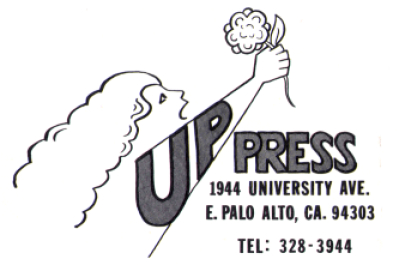
Palo Alto/Redwood City, 1972-1984, offset
Formed out of the South Bay community organization People’s Union, Up Press was a collectively-run movement press producing a wide range of work. In 1974 it became a women’s press, and merged with the Women’s Press Project in 1984.
The Women’s Press Project / The Women’s Press
San Francisco, 1974-1987; offset
The Mission-based nonprofit Women’s Skills Center set up the WPP for vocational skills training in the printing trade. They were collectively run, and moved to their own facility on Otis Street in 1980. In addition to the important task of helping women enter a traditionally male trade, the WPP also produced paid work to support themselves. They became a union shop in 1983, and were joined by Up Press the next year. They eventually closed down due to the departure of several key members, coupled with the challenge of serving as a training facility also producing commercial work.
Return to top of directory
Distribution
The Berkeley Bonaparte
Berkeley, 1967-1968
Berkeley
Bonaparte was an artists’ cooperative founded to produce and distribute
psychedelic poster art. Founded by Cummings Walker and Louis Rappaport,
it was included the work of five of the biggest names in what was then
a new field – Rick Griffin, Alton Kelley, Stanley “Mouse” Miller,
Victor Moscoso, and Wes Wilson. A revolution within a revolution, it
was a deliberate alternative to what had already become the
counterculture establishment, the powerhouses of Bill Graham and the
Family Dog. Offerings included a mixture of photographic-based posters
as well as graphic art. Their mail order catalog poster was perhaps the
first of its kind in the country, and included political (portraits of
Lenin and Wilson’s groundbreaking “Are
we next?”) as well as rock and counterculture posters.
The Print Mint
Berkeley, 1965-1985
Founded
by New York refugees Don and Alice Schenker, the Print Mint was the
first and most influential retail store to disseminate the new poster
art of the 1960s. Located in the same building on Telegraph Avenue as
their friend Moe Moskowitz (Moe’s Books), the Print Mint soon became
the hub for this new medium. In 1966 they opened a second storefront in
San Francisco’s Haight-Ashbury district, but conflicts between
Moskowitz and the city over permits resulted in the SF store closing in
1967. In addition to buying local posters for resale, The Print Mint
also commissioned new work and ventured into the then-new business of
underground comix – they published the first Zap Comix in
1967 - and operated a small print shop on Folger Street in Berkeley.
Return to top of article
All content copyright
2012 Lincoln Cushing except for Greenleaf Press and Mission
Grafica entries.
Creative Commons usage applies - noncommercial usage permitted with
proper credit and notification, all other use requires request.
Return to Docs Populi - Documents
for the Public
Page originally mounted 9/8/2013; last revised 10/29/2025
